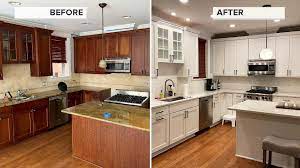When it comes to kitchen renovation in Vaughan , one of the most exciting aspects is the opportunity to transform the layout of your kitchen. A well-designed kitchen layout can significantly enhance functionality, maximize space, and create a more enjoyable cooking and dining experience. Whether you’re looking to update an outdated kitchen or personalize a new space, here are some valuable tips to consider when transforming your kitchen layout in Vaughan.
- Assess Your Needs: Before diving into any kitchen layout changes, take the time to assess your needs and lifestyle. Consider how you use your kitchen on a daily basis, your cooking habits, and the number of people who typically use the space. Identify any pain points or areas that could be improved. This self-assessment will help guide your layout decisions and ensure that the renewed kitchen caters to your specific requirements.
- Plan for Workflow: Efficient workflow is a key consideration when designing a kitchen layout. The three primary kitchen work zones are the cooking zone (stove, oven), the cleaning zone (sink, dishwasher), and the storage zone (refrigerator, pantry). Aim to create a logical and efficient flow between these zones to minimize unnecessary movement while cooking. A well-designed layout will allow for easy access to each zone, making meal preparation and cleanup a breeze.
- Consider the Kitchen Triangle: The kitchen triangle is a fundamental concept in kitchen design that involves positioning the stove, sink, and refrigerator in a triangular formation. This layout allows for efficient movement and workflow within the kitchen. When renewing your kitchen layout, try to maintain or optimize the triangle by positioning these three key elements in proximity to each other. However, keep in mind that the size and shape of your kitchen may require some modifications to the traditional triangle concept.
- Optimize Storage Space: Effective storage is crucial in any kitchen. Take advantage of your kitchen renewal to optimize your storage options. Consider installing custom cabinets and drawers that are tailored to your needs. Use innovative storage solutions such as pull-out shelves, dividers, and corner organizers to maximize every inch of available space. Well-organized storage will not only enhance the functionality of your kitchen but also contribute to a clutter-free and visually appealing environment.
- Focus on Ergonomics: Ergonomics play a significant role in a well-designed kitchen layout. Take into account the height and reach of family members who will be using the kitchen. Ensure that countertops, cabinets, and appliances are positioned at comfortable heights to minimize strain and promote ease of use. Consider incorporating features such as soft-close cabinet doors and drawers, adjustable shelving, and easy-to-reach pull-out features to enhance ergonomics and user experience.
- Create an Island or Peninsula: If space allows, consider incorporating an island or peninsula into your kitchen layout. Islands provide additional workspace, storage, and seating options, making them a versatile and practical addition. They can serve as a central hub for meal preparation, casual dining, or entertaining guests. Peninsula designs, on the other hand, are a great solution for smaller kitchens or those with limited space. They offer similar benefits to islands while utilizing existing wall space.
- Pay Attention to Lighting: Proper lighting is essential in any kitchen. It not only enhances visibility but also sets the mood and ambiance. When renewing your kitchen layout, consider a combination of task lighting, ambient lighting, and accent lighting to create a well-lit and inviting space. Incorporate under-cabinet lighting to illuminate work surfaces, pendant lights or chandeliers for a focal point, and recessed lights for overall illumination. Don’t forget to take advantage of natural light by maximizing window size or adding skylights if feasible.
